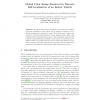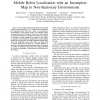289 search results - page 16 / 58 » Learning Landmarks for Robot Localization |
ICRA
2006
IEEE
15 years 5 months ago
2006
IEEE
— In this paper we present a technique to linearly recover 2D structure and motion in man made environments from three uncalibrated omnidirectional views. We use vertical lines f...
116
click to vote
AAAI
1994
15 years 1 months ago
1994
To navigate effectively, an autonomous agent must be able to quickly and accurately determine its current location. Given an initial estimate of its position (perhaps based on dea...
103
click to vote
CAIP
2005
Springer
15 years 1 months ago
2005
Springer
Abstract. In autonomous indoor navigation some number of localizations and orientations of the vehicle can be learned in advance. No artificial landmarks are required to exist. We...
ICRA
2009
IEEE
15 years 6 months ago
2009
IEEE
— Inverse-depth parameterization can successfully deal with the feature initialization problem in monocular simultaneous localization and mapping applications. However, it is red...
ICRA
2003
IEEE
15 years 5 months ago
2003
IEEE
— One of the fundamental problems of the mobile robots is self-localization, i.e. to estimate the self-position by comparing sensor data and a map. In non-stationary environments...


